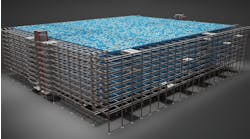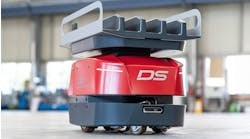Are You Ready? How the NYC 'Styrofoam Ban' Could Transform the Supply Chain
That means no more Styrofoam cups, bowls, plates, or takeout containers can be used by businesses in the city. Companies using Styrofoam peanuts for shipping — what the industry refers to as "polystyrene loose fill packaging" — will also need to find alternatives.
To better understand the ban's potential impact and discuss the growing interest in protective packaging solutions that can improve supply chain sustainability, we recently caught up with Dr. Ronald Cotterman, Sealed Air's vice president of sustainability.
Q1: How concerned do you think business owners should be about the NYC EPS ban?
Business owners who are affected by the EPS ban should consider this an opportunity to review and enhance their business's sustainability offering. Companies are already beginning to reassess their shipping and protective packaging strategies to be more sustainable overall; and, often, this means improving protection, minimizing returns due to damage, and reducing overall cost for the business's e-commerce efforts.
Thankfully, there are now many cost-effective, alternatives to expanded polystyrene (EPS). This should help shippers make the transition smoothly and ensure a high rate of compliance. Many of the alternatives previously had limited availability and there was a general lack of awareness about their benefits.Q2: Do you anticipate that the NYC ban may represent a tipping point for other municipalities?
Cotterman: It will likely heighten awareness and expand the momentum that's already been generated over the past few years.
Today, there are more than 70 other cities nationwide that have enacted similar bans or restrictions on EPS products, including Washington, D.C., San Francisco, Portland and Seattle. So, this is not a new trend, nor is it a short-term phenomenon.
Moving forward, you'll likely see more initiatives calling for this type of legislation. That's why leaders in the packaging and waste management industries, as well local governments, need to work together on implementing solutions that work for business and the environment.
Beyond compliance with new environmental regulations, we're seeing more companies take proactive approaches to assessing their shipping and packaging strategies. Businesses are seeking protective packaging solutions that enable more sustainable supply chains, along with supporting their e-commerce efforts. Specifically, they want to use technologies that provide exceptional product protection, minimize damage returns, are efficient to transport and capable of being recovered after use.
There is also a growing trend among established companies and e-commerce entrepreneurs to look at protective packaging as a vital part of their business — not just as a means of transporting their products.
They are looking at protective packaging solutions as a way to differentiate their business from competitors, enhance consumer experience and support brand identity.
While this is something commonly associated with high-end fashion and luxury goods, this is also happening more and more in other markets, including automotive accessories, consumer electronics and sporting equipment, just to name a few.
Q3: What is sustainable packaging and how can it be used more effectively?
Cotterman: Sustainable packaging not only refers to the type of materials used, but also how effective the overall shipping process is on an end-to-end basis. Choosing the right-sized box or optimal protective packaging solution improves any business's overall sustainability by using fewer materials more effectively, while minimizing shipping costs associated with large packaging, as well as the amount of returns due to damage. While too little packaging results in product damage and increased returns, too much packaging is expensive and wasteful. The amount and type of packaging must be optimized, keeping the full life cycle in mind.
There are, however, a number of sustainable, recyclable and compostable solutions in the market. Products that biodegrade when composted or that can be recovered and recycled after use, can be valuable options.
Our research and development efforts at Sealed Air focus on delivering innovative packaging solutions that work for business and the environment.
For example, long before the increase in EPS bans and restrictions, we developed our popular PakNatural loose fill — a protective packaging product made from 95% non-food, renewable materials that is certified to be compostable and biodegradable.
We also offer our Sealed Air Restore Mushroom Packaging, a 100% renewable protective packaging solution is made from non-food agricultural byproducts and mycelium, or "mushroom roots."
And of course there are still plenty of additional protective alternatives produced from more traditional materials that will help businesses comply with polystyrene limitations and offer recyclability after use. These include every kid's favorite, Bubble Wrap, as well as those Fill-Air inflatable bags popular with a number of e-commerce companies. Sealed Air also has a number of fiber-based solutions, including PackTiger paper systems and Korrvu retention and suspension systems.
But whatever solution they eventually pick, we recommend businesses take a proactive approach and ensure they work with trusted packaging distributors and suppliers. Doing so can help them find the right protective packaging solutions for their business and ensure compliance with the new legislation.
Dr. Ron Cotterman is Vice President, Sustainability, at Sealed Air Corporation and is responsible for the company's global sustainability strategy. He leads initiatives in operational excellence, delivering customer value and achieving Sealed Air's vision to create a better way for life. Active in numerous organizations including the Consumer Goods Forum, the World Wildlife Fund, and The Sustainability Consortium, Ron is also a lecturer at Furman University and a member of the advisory board of Michigan State University. He earned an undergraduate degree in Chemical Engineering from the University of Florida and a PhD in Chemical Engineering from the University of California, Berkeley









